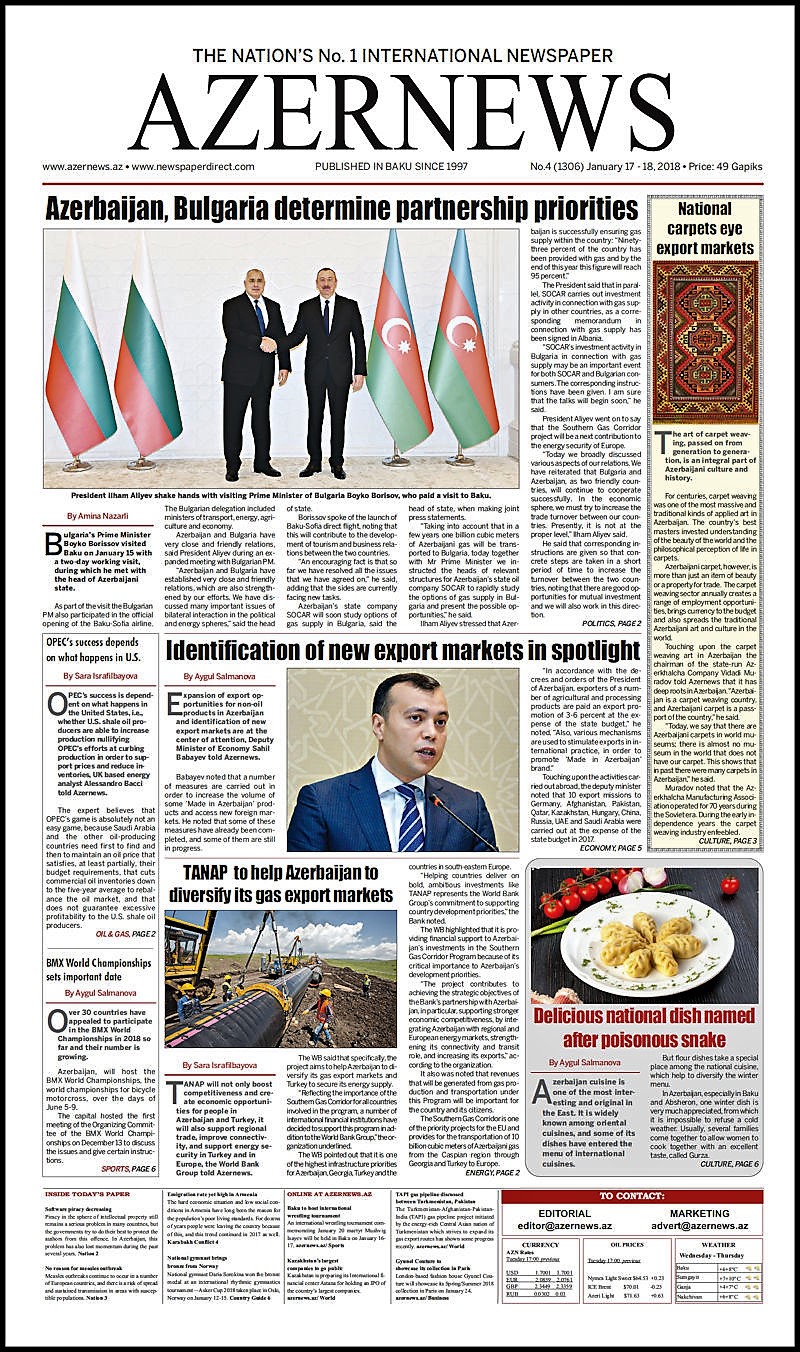Below you may read my comments about OPEC and oil prices, which I emailed to Ms. Sara Israfilbayova, a business journalist with Azernews, an
English-language Azerbaijani newspaper. Ms. Israfilbayova had asked me some
interesting questions about the present state of the oil markets. After my
reply, Ms. Israfilbayova introduced my comments into her article “Expert: OPEC’s Success Depends On What Happens in U.S. (INTERVIEW),” which was
published by AzerNews, first, on January 15, on its online edition, and then, on
January 17-18, in its paper edition.
January 15, 2018
LONDON
Q1. The OPEC+ decided to
extend its production cuts till the end of 2018. Do you think it will be
effective or not? Is there any chance of new countries joining the agreement?
It’s difficult to know whether the decision of prolonging by
nine months the production cuts (in total 1.8 million barrels per day out of
the market) until the end of 2018, taken by the Organization of Petroleum
Exporting Countries (OPEC) and some non-OPEC producers including Russia at the
end of November 2017, will be effective until December 2018. However, what is sure
is that when the decision was taken, the production cuts were conceived as a component
that might help to at least partially stabilize the oil prices—OPEC countries
and the non-OPEC countries included in the agreement represent almost 60
percent of global oil production.
Extending the cuts, OPEC and some non-OPEC oil-producing
countries, the latter led by Russia, did probably the right move in their quest
to fight the global supply glut and to keep oil prices at about $60 per barrel.
In addition, it was a good result the inclusion of Nigeria and Libya, two OPEC
members that because of internal problems (attacks on oil facilities in Nigeria
and an ongoing civil war in Libya) had previously been exempted from the initial
cuts. If the deal goes through the whole 2018, the 24 countries that are now
party to the agreement must stuck to their commitments. In December 2017, the
OPEC members implemented 121 percent of the pledged cuts showing an optimal
adherence to the deal—in total OPEC pumped about 32.47 million barrels of oil in
December.
The extension deal will be reassessed in June 2018 at OPEC’s
next scheduled meeting. In specific, this point is quite important to Russian
oil companies, which wanted only a six-month extension and not a nine-month
extension. In fact, Russian companies consistently fear that the already higher
oil prices might permit the U.S. shale industry to gain market share at their
expense.
Q2. What are your
predictions for the oil prices after the deal prolongation in 2018?
In these initial days of 2018, Brent prices are close to $70
per barrel, the highest value since 2014. However, there are several signs that
market might be overheating. In practice, we have probably arrived at these
prices too prematurely. Prices are currently high because of several factors.
Among the most relevant, it’s worth mentioning: the extension cuts, declining
inventories in the U.S. (partially linked to cold weather conditions as well),
unrest in Iran and other areas, strong global economic growth, and oil future
purchases by hedge funds and financial institutions (long positions). In
specific, with reference to economic growth, recently the U.S. Energy
Information Administration (E.I.A.) raised its 2018 world oil demand growth by
100,000 bbl/d from its previous estimate. If oil prices continue to be about
$60 to $65 a barrel, it’s more than probable that U.S. oil production might
well be on the rise again.
Over the course of the past months, Saudi Arabia and Russia
have discussed consistently about a target price floor that could permit them
to support oil prices, reduce the oil glut, and avoid losing market share to
the benefit of the U.S. shale oil producers. The idea was that the best floor
price was about $60 per Brent barrel. In addition, in the United States, 2017
was the year of an important mindset change across shale oil producers. In
practice, from a growth-at-any-cost approach, shale oil producers realigned
themselves with the basic concepts of return on capital and cash flow
generation. However, if West Texas Intermediate (W.T.I.) rises and stays above
$60, it will be quite difficult not to experience an increase in the U.S. shale
oil production because, at that value, companies could consistently expand
their profitability margins.
In practice, according to Barclays, at $60 a barrel, in 2018 U.S.
shale production could increase by 1.4 million barrels per day (versus 1
million barrels at $50 to $55 a barrel), which would be equivalent to
neutralizing almost one quarter of the OPEC/non-OPEC implemented cuts. In sum,
this would mean lower oil prices. Of course, if a major geopolitical event
occurs—for instance, an intensification of the proxy wars between Saudi Arabia
and Iran or additional turmoil in Venezuela—this might always produce undersupplied
markets, i.e., higher oil prices.
Q3. The success of OPEC
largely dependents on the U.S. Thus, the OPEC countries face a dilemma. On the
one hand, they need high prices, and on the other, prices should not reach such
a high level, because in this case it will push the U.S. to increase production
of shale oil. In your opinion, what should be done in this case?
Definitely, OPEC’s success is dependent on what happens in the
United States, i.e., whether U.S. shale oil producers are able to increase
production nullifying OPEC’s efforts at curbing production in order to support
prices and reduce inventories. Indeed, OPEC’s game is absolutely not an easy
game, because Saudi Arabia and the other oil-producing countries need first to
find and then to maintain an oil price that satisfies, at least partially,
their budget requirements, that cuts commercial oil inventories down to the
five-year average to rebalance the oil market, and that does not guarantee
excessive profitability to the U.S. shale oil producers. Of course, such an
equilibrium is not easy to achieve and to maintain.
The next six months will tell us a lot more about how the U.S.
shale oil industry will respond to these new higher prices. It’s evident that if
shale oil output begins to increase faster than it was expected, OPEC and
non-OPEC oil producing countries will be forced to halt production cuts earlier
than they have thought. For the time being, according to Saudi Arabia, in
December 2017, O.E.C.D. inventory stocks were still 150 million barrels too
high. In addition, calendar spreads for 2018 have tightened significantly over
the last six months hinting at a sustained period of oil undersupply. In
general, drilling rates, i.e., an increase in production, follow the changes in
the future markets with a gap of 4 to 5 months.
Q4. What other method can
be offered to balance the oil market?
No, too much is currently at stake in order to think of other reliable
and implementable strategies to balance the oil markets. In specific, the
emergence and the real impact of the U.S. shale oil industry must still be
fully understood. As mentioned above, only in the past year has the U.S. shale
oil industry succeeded in implementing a more financially sound behavior. On
top of this, if on the one hand, the 24 countries that are now party to the
agreement concerning the production cuts have been able to extend the cuts, on
the other hand, they have already shown significant differences concerning the
strategy for managing oil prices.




No comments:
Post a Comment
Note: Only a member of this blog may post a comment.